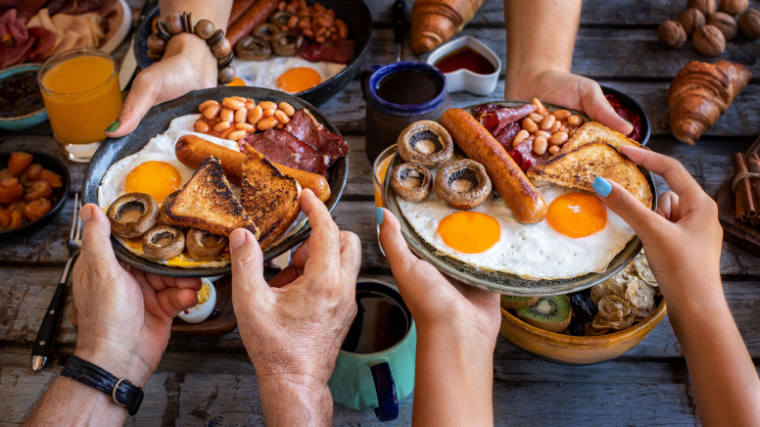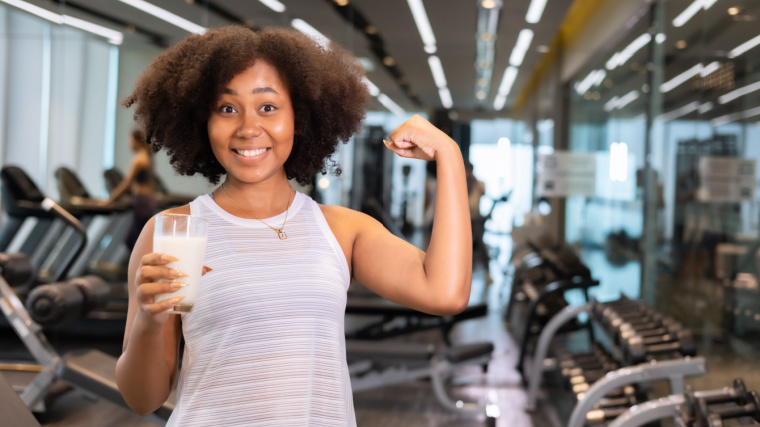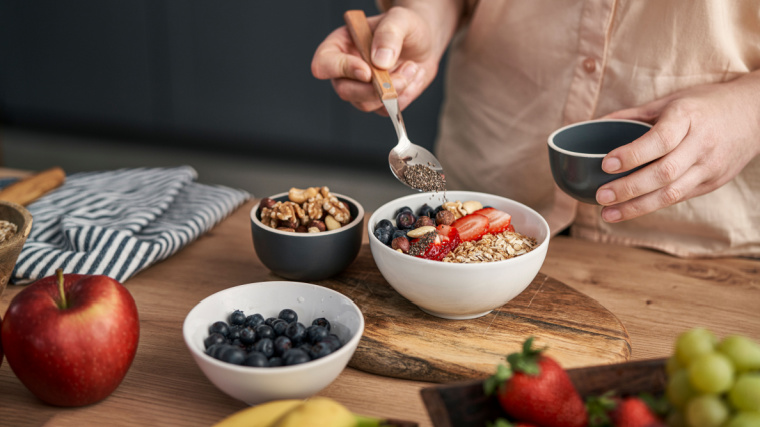With all due respect to fats and carbohydrates, proteins are the unquestioned muscle-building stars of the macronutrients. If you’ve spent enough hours immersed in a gym environment, you’ve likely heard about how you need abundant protein in your diet. And it’s true — protein is an absolute must if you want to achieve an optimal state of physical wellness.

If you can access both traditional and atypical food sources, and maybe even build some safeguards into your meal planning, you will likely have no trouble acquiring all the protein you can handle. By getting strategic with your protein intake (and bodybuilding program), you’ll be on track to bulk up, stay healthy, and support your other fitness goals.
Here, you’ll gain all the strategies you need about how to eat more protein to fuel that muscle growth.
- What Is Protein?
- The Benefits of Eating More Protein
- 18 Ways to Add More Protein to Your Diet
- How Much Protein Should You Eat Daily?
- Should You Take a Protein Supplement?
- Frequently Asked Questions
What Is Protein?
Proteins — which are composed of chemical building blocks called amino acids — are one of the three essential macronutrients you consume as food. (1) Aside from delivering four calories to your body per ingested gram, protein builds and repairs your tissues after exercise has broken them down. (1) If you want large muscles, monitoring your protein intake is vital to your success.
The Benefits of Eating More Protein
Everything from protein shakes to protein powder is all the rage in gym culture for a reason — well, several reasons. Here are just some of the potential benefits of kicking back more protein in your diet, in combination with high doses of resistance training.
- Larger, stronger muscles
- Increased satiety with less overall food intake
- Improved enzyme function
- Enhanced healing properties
All protein is composed of amino acids, but protein sources must contain nine essential amino acids in order to be considered complete. (2)
[Read More: 20 High-Protein, Low-Calorie Foods Worth Subbing Into Your Diet]
This means that protein completeness matters for fueling optimal performance. In addition, even amongst complete proteins, studies have shown that your body may respond differently to each of them with respect to strength gains. (3)
18 Ways to Add More Protein to Your Diet
If a nutritionist or dietitian has advised you to get more protein into your body, there are plenty of ways to accomplish this. Whether you’re looking to begin a high-protein diet, or you’re simply searching for alternative sources of high-quality protein, you can easily add higher protein content to your diet. You can also do so without straying from your fitness goals.
1. Don’t Go Hungry
One of the simplest strategies for adding more protein to your diet is to simply eat more food by responding to your body’s hunger signals — AKA, eat when you’re hungry. If you’re eating a balance of healthy foods that are loaded with other important nutrients, protein is bound to be part of that increased volume.
2. Got Milk?
It’s not just for building strong bones with calcium — though it does that, too — milk is also a solid source of protein. Some studies have suggested that milk is roughly as hydrating as water but with the additional quality of packing roughly one gram of protein per fluid ounce. (4)

[Read More: The 12 Best Fat Burners for Women]
Fun fact: milk is also the base of whey isolates and other whey protein powders. If you’re not vegan or allergic to dairy products, drinking milk can make a sizable improvement to your protein level.
3. Plan Your Meals
One of the simplest ways to ensure that you acquire enough protein is to plan for it. Even if you stick to eating three square meals per day, sliding protein into your soups or dropping some on top of your white rice or brown rice is a surefire way to ensure that box gets checked.
4. Space Things Out
If you prefer to eat often without necessarily consuming food in high volume, you can build a plan around eating a small protein source every two hours. Even eating as little as 20 grams of protein at a time can add up rapidly if you eat something every couple of hours between 8:00 a.m. and 10:00 p.m.
5. Yummy Yogurt
Yogurt is a valuable food resource due to its high calcium content and probiotic benefits. On top of that, most yogurt packs a high-protein punch. This makes it a tasty way to elevate your protein intake, either as a regular part of breakfast or as a healthy snack. You can also blend plain Greek yogurt into your smoothies to boost their content beyond the milk or protein powder.
6. Chomp Some Cheese
Cheese is a very nutrient-rich food item; a single slice of cheddar cheese contains more than 100 calories, along with calcium, and plenty of protein. Whether you’re casually eating slices of cheese, or adding cheese to burgers, omelets, or salads, it’s a simple way to boost the protein content of any food. Eating cottage cheese on its own will similarly do the trick.
7. Pile On the Powder
Protein powders can be made of anything from whey or pea to soy protein powder. Most protein powders will deliver serious protein to your body from 20 to 40 grams at a time. Each scoop of powder can amount to a major meal’s worth of protein. This means you can use protein powder in meal replacement shakes if you’re on the go or trying to maximize your daily intake.
8. Bedtime Snack
Avoiding late-night snacks is a common strategy for losing weight. But that post-dinner snacking may also be a good strategy for building muscle and encouraging overnight muscle growth and repair. Mixing a scoop of protein powder into your bedtime ritual will help you increase your daily protein intake without a whole extra meal.
9. Don’t Pass the Bar
If you’re the type of person who typically reaches for a snack bar, a protein bar would make for a perfect substitute.
[Read More: The 10 Best Mass Gainer Supplements]
There are plenty of protein bars that have the same flavor profile as candy bars, but which carry enough protein to exceed your typical snack.
10. Snack on Nuts
If you’re into snack foods like potato chips and popcorn for the salt content, you may want to consider replacing them with a half-cup of almonds or pistachios. That way, you can satisfy your salt cravings while doubling as a relatively high-protein snack that fulfills your need for healthy fats, as well.
11. Leap for Legumes
If you’re in search of a good vegan protein source, you need look no further than the family of legumes. From black beans to soybeans to lentils and chickpeas, legumes offer you a very nutrient-dense food option. Peanuts are also technically legumes, which makes peanut butter a worthy selection, as well.
11. Eat Some Eggs
One of the things that makes eggs so versatile is how quickly they can be cooked and served alongside other items. Cooking up a four-egg omelet first thing in the morning will start your day with 24 protein grams of the highest quality. Or if you prefer to use eggs as a garnish, one large egg added to your burger will add up to eight grams of protein to your daily tally.
12. Pound Some Pancakes
Whether they’re a Sunday morning tradition or a daily ritual, modern pancakes are no longer required to be the high-carbohydrate, high-sugar meal they’ve historically been. High-protein breakfast pancake mixes can administer between 10 to 20 grams of protein to your growing muscles.
13. Munch Some Meat
Eating meat is such an easy way to acquire protein. A 100-gram portion of turkey breast contains 30 grams of protein, which is about the same ballpark as an entire chicken breast. (5)(6) If you’re consuming at least three meals a day that all have a significant meat source, it is difficult not to consume a respectable quantity of protein.
14. We All Scream for Ice Cream
Unless you’re going non-dairy, ice cream typically contains milk and, well, cream. Low-sugar, high-protein ice creams have flooded frozen food sections across the globe, so now your frosty indulgence can be a way for you to sneak some extra protein into your diet.
15. Competent Coffee
Aside from being an essential caffeinated pick-me-up, coffee is also famous for being a fairly blank slate as far as macronutrients are concerned. However, coffee has also been proven to sustain itself well when other ingredients are added to it. Coffee mixes are now available that carry the flavor and caffeine you’re looking for, along with preloaded doses of whey protein.
16. Pour Some Cereal
Breakfast cereals are still early morning reservoirs of necessary carbs and whole grains. Despite this, many major cereal brands have produced protein-rich alternatives to their most popular products.

[Read More: The 12 Best Vegan Protein Powders]
So if you prefer to start your morning with additional protein, you can do so, all while fulfilling your protein and taste bud needs.
17. Go Easy on the Alcohol
You can consume as much protein as you want. But if your body isn’t absorbing it properly, it’s not going to do you nearly as much good. Consuming alcohol inhibits muscle protein synthesis, meaning that protein plus alcohol may cancel out some of those immediate protein benefits. (7)
18. Enhanced Oatmeal
Similar to breakfast cereals, many forms of oatmeal have sprung up that have had their protein content boosted by whey, soy, or other types of protein. Whether you enjoy your oats hot, or you’re a fan of overnight oats, there are plenty of oatmeal options to help you kick off your day with a hefty protein dose.
How Much Protein Should You Eat Daily?
The amount of protein you should devour daily depends on what your goals are. If you’re trying to gain mass, maintain your size, or lose weight, your personal desires play a factor in identifying the ideal dose of protein for you.
[Read More: Whey Protein vs. Casein Protein — What’s the Difference and Which is Better for Muscle and Strength?]
Plug your goals into the BarBend protein intake calculator to get personalized results, below:
Protein Intake Calculator
Age
Sex
Height
Weight
Goal
Activity Level
Do you know your body fat percentage?
The General Recommendation
The recommended daily allowance (RDA) for protein set by the Food and Nutrition Board (FNB) is 0.8 grams of protein per kilogram of body weight, or 0.36 grams per pound. (8) So if you weigh 150 pounds, you should ingest 54 grams of protein each day to meet the recommended allotment.
The Guide To Getting Larger
The recommendation from the American College of Sports Medicine (ACSM) is that individuals interested in gaining muscle should potentially double the RDA for protein intake. (9)
[Read More: The 10 Best Protein Powders for Muscle Gain]
If you enjoy resistance training or other strenuous exercise, ACSM guidelines suggest consuming 1.2 to 1.8 grams of protein per kilogram of body weight. (9) This equates to 0.5 to 0.8 grams per pound.
The Bodybuilding Baseline
If you are a competitive bodybuilder, it has been a general guideline that one gram of protein per pound of body weight is an ideal target for maximizing muscle growth. While this will certainly ensure that you acquire adequate protein, study results suggest that protein intakes exceeding 1.62 grams per kilogram (0.73 grams per pound) are superfluous. (10)
How Much Protein Can Your Body Use at One Time?
Even after arduous exercise, the difference in muscle protein synthesis between study participants who ingested 20 grams of protein and 40 grams of protein was nearly negligible. (11) If you’re like most people, your targeted size for an efficient ration of protein will lie somewhere between 20 and 40 grams, with diminishing returns as serving size climbs above 20 grams.
Can Too Much Protein Be Harmful?
Most of the concerns about high-protein diets presume that you’re consuming animal proteins that are high in saturated fat, which can raise your cholesterol level and cause heart disease. However, long-term high-protein diets might damage your kidneys, regardless of their fat content. (12) That can lead to an increase in both blood pressure and toxin quantity in your system.
Should You Take a Protein Supplement?
Your decision to take a protein supplement should be based on your personal goals and circumstances.
[Read More: The 7 Strongest Pre-Workouts]
If you are hoping to sustain your existing body weight, or to maintain your current muscle mass while prioritizing weight loss, fulfilling the RDA of protein for your current weight is probably sufficient. Then again, if you wish to gain mass, supplementing with a quality protein source may not hurt, and may in fact prove quite helpful.
The Choice Is Yours
There are several imaginative ways that you can eat more protein, repair muscles, and increase strength. Be mindful of how many of these options you select for elevating your protein intake.
After all, protein may be essential — and often tasty — but it’s still possible to have too much of a good thing. Stay within the recommended guidelines, train hard, and get ready for growth.
FAQs
If you have questions about quick and efficient ways to raise your protein intake, we have suggestions for you!
According to the protein efficiency ratio (PER), eggs are the most efficient source of high-quality protein you can ingest. Eggs are used as the protein-completeness standard against which all other protein sources are measured, with a biological value of 100 out of 100. (13)
There are several ways to increase your protein intake. They include the consumption of natural foods that are scientifically proven to be high in protein, and the substitution of low-protein foods with protein-enhanced alternatives.
The FNB’s general recommendation for protein intake is at least 0.36 grams of protein per pound of body weight. The peak recommendation provided by the ACSM is 0.8 grams of protein per pound of body weight. Following these two guidelines, a person weighing 200 pounds would be advised to consume at least 72 grams of protein daily, and no more than 160 grams.
References
- MedlinePlus [Internet]. Bethesda (MD): National Library of Medicine (US). Medical Encyclopedia: Protein In Diet.
- National Research Council (US) Subcommittee on the Tenth Edition of the Recommended Dietary Allowances. Recommended Dietary Allowances: 10th Edition. Washington (DC): National Academies Press (US); 1989. 6, Protein and Amino Acids.
- Demling RH, DeSanti L. Effect of a hypocaloric diet, increased protein intake and resistance training on lean mass gains and fat mass loss in overweight police officers. Ann Nutr Metab. 2000;44(1):21-9.
- Berry CW, Wolf ST, Murray B, Kenney WL. Hydration Efficacy of a Milk Permeate-Based Oral Hydration Solution. Nutrients. 2020 May 21;12(5):1502.
- “Calories in 100 G Turkey Breast.” Nutritionix.com.
- “Calories in Chicken Breast.” Nutritionix.com.
- Parr EB, Camera DM, Areta JL, Burke LM, Phillips SM, Hawley JA, Coffey VG. Alcohol ingestion impairs maximal post-exercise rates of myofibrillar protein synthesis following a single bout of concurrent training. PLoS One. 2014 Feb 12;9(2):e88384.
- Beasley JM, Deierlein AL, Morland KB, Granieri EC, Spark A. Is Meeting the Recommended Dietary Allowance (RDA) for Protein Related to Body Composition among Older Adults?: Results from the Cardiovascular Health of Seniors and Built Environment Study. J Nutr Health Aging. 2016;20(8):790-796.
- American Council of Sports Medicine. “Protein Intake for Optimal Muscle Performance.” 2015. Retrieved October 15, 2023.
- Morton RW, Murphy KT, McKellar SR, Schoenfeld BJ, Henselmans M, Helms E, Aragon AA, Devries MC, Banfield L, Krieger JW, Phillips SM. A systematic review, meta-analysis and meta-regression of the effect of protein supplementation on resistance training-induced gains in muscle mass and strength in healthy adults. Br J Sports Med. 2018 Mar;52(6):376-384.
- Stokes T, Hector AJ, Morton RW, McGlory C, Phillips SM. Recent Perspectives Regarding the Role of Dietary Protein for the Promotion of Muscle Hypertrophy with Resistance Exercise Training. Nutrients. 2018 Feb 7;10(2):180.
- Kamyar Kalantar-Zadeh, Holly M Kramer, Denis Fouque, High-protein diet is bad for kidney health: unleashing the taboo, Nephrology Dialysis Transplantation, Volume 35, Issue 1, January 2020, Pages 1–4.
- Hernández M, Montalvo I, Sousa V, Sotelo A. The protein efficiency ratios of 30:70 mixtures of animal:vegetable protein are similar or higher than those of the animal foods alone. J Nutr. 1996 Feb;126(2):574-81.
Featured Image: Gulcin Ragiboglu / Shutterstock
The post 18 Ways to Eat More Protein to Pack on Muscle Mass appeared first on BarBend.
